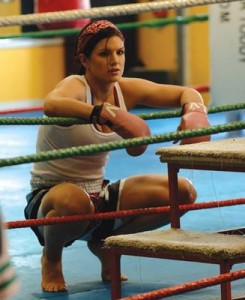by guest author Candace Stump

In between beatdowns, MMA fighter Gina Carano demonstrates hip flexion.
Yoga means, among other things, “yoking” or “unity”. Traditionally this means unity of body, mind, and breath; the breath being the most important.
One of the most effective ways to think of yoga is as sophisticated relaxation: freedom from unnecessary tension in body, mind, and breath. This does not mean lying down doing nothing! This means using the *least* amount of effort necessary to achieve results. (Sound familiar, grapplers?) Even if that result is a very, very difficult pose.
Most BJJ practitioners, grapplers, and MMA fighters end up with certain muscles totally overdeveloped. I’d like to start with psoas.
The psoas (SO-az) is the main muscle linking the upper body to the legs at the front of the hips. Because of the way BJJ works, the psoas gets very, very tight. I am always surprised when any BJJ or MMA player can sit up completely straight; most have such tight psoas muscles that they can no longer do this.
However, many non-grapplers also have a lot of psoas problems, simply from sitting all day in hip flexion, with thighs at 90 degrees to the torso. The psoas shortens and becomes tight.
An overdeveloped, shortened psoas means less mobility, reduced speed, and greater risk of injury. It tips the front of the pelvis forward and gives us “duck-butt”. It’s more or less abuse of the spine, which will eventually cause back pain.
Poses for relaxing the psoas
| Supta Padangusthasana (Reclined hand-to-big-toe)* |
|
| Parvrrta Supta Padangusthasana (Revolved reclined hand-to-big-toe) |
|
| Utthita Trikonasana (Extended triangle) Don’t dump into this. Take your time. |
|
| Virabhadrasana II (Warrior II) Knee over second toe. BEND into this. |
|
| Eka Pada Rajakapotasana (One legged pigeon) |
|
| Bhujangasana (Cobra) Chest forward as your tailbone moves toward your heels. Pull your spine apart! |
|
| Vrksasana (Tree) Spin your lifted buttock under, toward your standing heel. Lift your armpit chest! |
|
| Virasana (Hero) Use a block if you need one. |
|
| Ustrasana (Camel) Do this at the wall! Push hips into the wall and LIFT your chest. |
|
| Supta virasana (Reclining hero) DEFINITELY support your upper back. |
|
| Dhanurasana (Bow) Knees IN. |
|
| Urdhva Dhanurasana (Full wheel, or modified: head to floor) Knees and elbows IN! |
*If you cannot remember the pose by reading it, try going to the Yoga Journal site and typing in the Sanskrit name in the search box. You’ll get a picture and description.
**If you are new to yoga or need a different variation, check out this article… it walks you through ten simple ways to release the psoas.
I also recommend a few abdominal strengthening poses.
Good luck. Enjoy your practices, all of them, in good health.
Namaste!
“One of the most important skills in any field is learning what to ignore.”